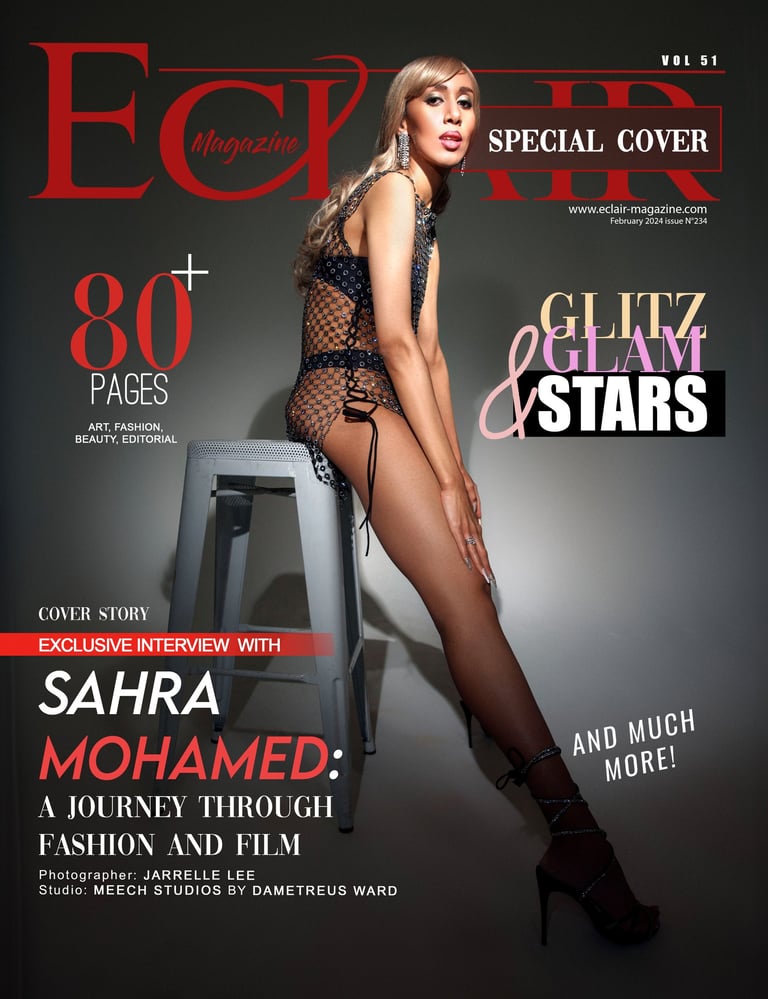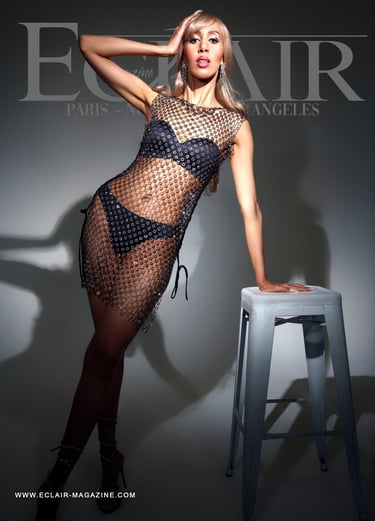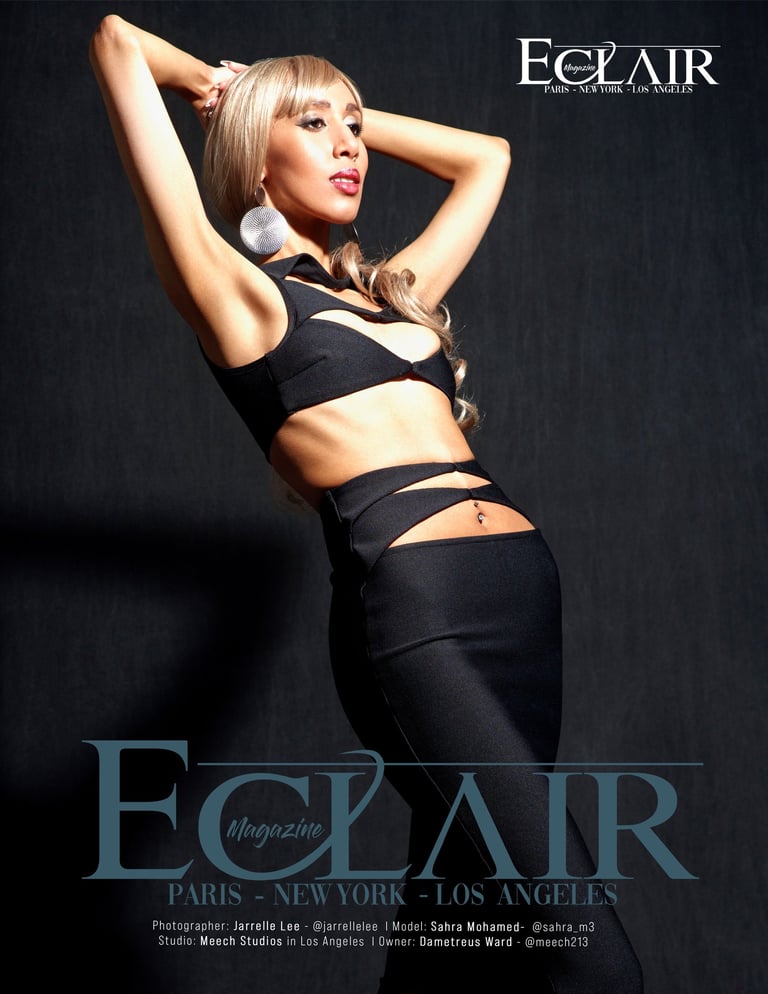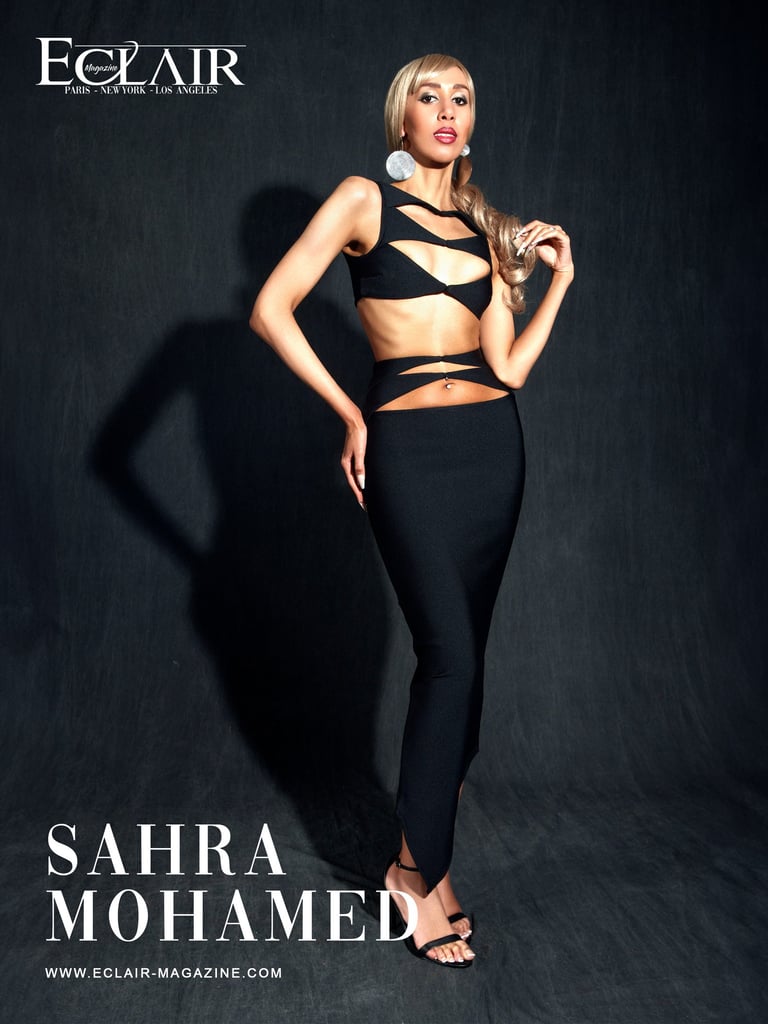SUCCESS STORY
Sahra Mohamed:
A Journey Through Fashion and Film
By Guillaume Jean Lefebvre


Sahra Mohamed, originally from Somalia, is a name resonating in the realms of both fashion and film. Born in Ottawa and raised in Vancouver, Canada, her childhood was marked by a profound artistic inclination.
From a young age, Sahra exhibited a love for exploration, delving into fashion and storytelling. Expressing herself through unique looks and ever-evolving hairstyles, her passion culminated in a pivotal moment at 17 – her first runway show. The experience of owning the stage and embracing her identity as a young black woman set the foundation for her future endeavors.
Sahra pursued film production and screenwriting in film school while simultaneously making waves in the modeling world. International fashion shows and collaborations with diverse designers shaped her understanding of both fashion and filmmaking. The collaborative nature of these industries became a cherished aspect of her journey.
After graduating, Sahra navigated the corporate law landscape, applying her skills to decipher international contracts, crucial in the unregulated fashion industry. Early experiences taught her to trust her instincts and prioritize safety, ensuring every collaboration met stringent vetting criteria.
Her academic pursuits extended to screenwriting, film production, advanced business management, and digital journalism. Recently obtaining an Associate’s Certificate in Radio, Arts & Entertainment, Sahra's commitment to continuous learning is evident.
Key moments in her career include unraveling the legalities of the fashion industry and shedding light on issues like eating disorders, sexual harassment, wage theft, and racial discrimination. Her essay on The Fashion Worker’s Act for Model Alliance marked a significant contribution to advocating for basic labor protections in the industry.
Approaching her work with a deep fascination for editorial storytelling and emotive imagery, Sahra draws inspiration from iconic supermodels. Confidence, she believes, is paramount in modeling, and every shoot is a unique and purposeful endeavor.
Proud of her education and international cover features, Sahra values knowledge as a powerful tool. Balancing a fast-paced lifestyle, she emphasizes the importance of mental well-being and surrounds herself with a supportive tribe.
Looking ahead, Sahra aspires to run her own fashion publication, creating a safe space for artists to share their stories. Her vision includes a magazine that addresses political topics, explores contract legalities, and advocates for safe regulations in the industry.
Perceived as a kind-hearted individual with unwavering passion, Sahra Mohamed stands as a beacon in the world of artistry, valuing family, people, and the profound impact of storytelling.
BIOGRAPHY
1. Sahra, your childhood was marked by a strong artistic inclination. Can you share specific moments or influences that sparked your love for exploring fashion and storytelling from a young age?
As a young girl, I loved my mom's fashion style; I was in awe of her work attire. I loved seeing her get dressed every morning, and she always wore this rich, beautiful burgundy lipstick from L’Oréal. I couldn’t wait to have the same one and wear it too! My mom and I would often go shopping together, and being raised by a single mom, our budget would be tight at times. However, she always found a way to surprise me with something I really wanted, whether it was a new dress, a purse, or even going to the hair salon to try a new color. She created a loving environment, and I was free to explore and experiment. I’ll always be grateful to her for doing that.
When it comes to storytelling, writing was a way to express myself, and I also had a wild imagination. When I was in elementary school, I wrote a short novel about a little girl in an orphanage. I was nine at the time, and it was hard for me to understand why people are living a certain way, why they are deprived, why are children suffering? At that age, I kept asking all these open-ended questions. As a result, I wanted to write a story about a child who endured hardship but was able to overcome it. Storytelling became an outlet for me to address issues and express my views through characters. In this case, the little girl in the orphanage got adopted into a loving home.
It’s no surprise that I ended up studying film production and screenwriting because storytelling is a powerful gift. It enables us to empathize with one another, to have more compassion for humanity, which is much needed today.
2. At 17, you had a transformative experience with your first runway show. How did that moment shape your perception of yourself and influence your journey in the fashion and modeling industry?
I remember feeling confident and extremely excited to be on the runway for the first time. I love doing photoshoots, but runways are such a thrill. There’s an audience present, you feel the music and the sensation. I quickly realized that it was not only a moment for me but for the designer. They work so hard to have their collections be seen, especially when it’s picked up by prestigious publications. It’s an incredible experience.
However, I hope the casting process gets easier for models. There were many instances where I was told my measurements needed to be smaller. When I did, I ended up having health issues due to the small frame. In France, a rule was implemented that models with a body mass index of 0 couldn’t be booked in Paris Fashion week. When I was modeling in the states, my BMI was severely low. I was 00, and I was being booked and working frequently.
I had to remind myself of who I was at 17, a confident, healthy young girl. I needed to go back to that, even if it meant losing job opportunities for gaining 1 or 2 inches. I was willing to take that risk.
Nowadays, it’s a relief to see changes in the fashion world. My biggest hope is that these harsh tactics used to keep models thin on runways are eliminated. It’s time to start enjoying the artistry of modeling from a healthy standpoint and set better standards, especially for young models who enter the industry.
Photographer: Jarrelle Lee - @jarrellelee
Model: Sahra Mohamed - @sahra_m3
Studio: Meech Studios in Los Angeles
Owner: Dametreus Ward - @meech213


3. Pursuing film production and screenwriting in parallel with a successful modeling career is impressive. Can you elaborate on how these two seemingly distinct paths intersected and complemented each other in your professional journey?
The process of filmmaking and modeling are quite similar; there’s a story and a message that we are trying to showcase through cinema and imagery. The two worlds collide, and it becomes a seamless transition to understand the elements of filmmaking and editorials. Over time, I understood the production elements, including lighting, sound design, and photography. I knew the quality of the cameras that the photographers were using, which made me appreciate the shoot that much more. I knew the significance of working with a cinematographer who understands how to capture the right types of movement. Whether I was on a film set or a photoshoot, I wasn’t just showing up to work; I was showing up to also learn and appreciate the abundant talent that was surrounding me. In a way, it made me become more passionate about my work, and I was inspired to create things for a purpose. I had opportunities to work with photographers who later became videographers. The fashion & film world are intertwined, and what a privilege it is to create something incredibly meaningful and memorable. To me, that is the definition of a true artist, to make something, an iconic design, an image, or a film, that will last forever.
4. You've had the opportunity to model for numerous fashion designers globally. How has exposure to diverse cultures and artistic expressions influenced your perspective and approach to both fashion and filmmaking?
I take the time to understand the intention of the artist and their vision. When I’m working, my goal is to bring the designer’s vision to life. Not only am I wearing beautifully curated fabrics, but I’m also channeling the woman they are envisioning. It’s also important for me to work with designers who come from different backgrounds and cultures. I’m always inspired when people of color and members of the queer community are highlighted. It enables me to understand fashion from different parts of the world, and I love learning about the origin of certain garments and wearing them with pride. With filmmaking, the process is similar. When I’m working with a director, I take the time to understand their artistic direction and, as a producer, bring that to fruition. It greatly benefited my personal life as well. I’m attentive, and I take the time to listen more. A lot of patience is needed when working collaboratively to ensure a successful project. What we are doing creatively and what we’re able to create logistically is different at the beginning. When the two collide, that’s when the magic begins.






5. Your foray into corporate law firms provided tools to navigate the unregulated fashion industry. Could you share an instance or lesson from that period that significantly impacted your understanding of the legal dynamics in the fashion world?
Working in law empowered me to advocate for myself when deciphering international modeling contracts. I’m not able to provide specific examples of contracts that I’ve signed, but I can speak on the nuances and the importance of consulting with a lawyer before signing them. Some modeling firms are not like talent agencies; they’re not regulated or licensed. Many top modeling agencies are known for being management companies, which enables them to find loopholes in labor laws. In addition, models have to look for the term “Power of Attorney” on their contracts and be very cautious if they ever see this present. This means that agencies can accept payments on the model’s behalf and are not required to reveal where the funds are allocated. Some agencies engage in auto-renewing contracts, regardless of whether the agents booked jobs for their models or not. When this happens, models who do get work often find themselves in debt due to financial discrepancies, placing them in a vulnerable position to predators who can take advantage of their earnings. When agents are scouting models as young as 14, it’s crucial that parents understand the legalities and the consequences of international contracts. According to the global fashion industry statistics, the industry is estimated to be worth 1.7 trillion dollars. Therefore, agencies can afford to pay models fairly for services rendered.
6. With a diverse academic background, including screenwriting, film production, and journalism, how have these educational experiences enriched your professional career and contributed to your holistic understanding of the industries you're involved in?
In film school, I was able to express my views through storytelling and use powerful themes to convey messages about issues that were close to my heart. Journalism enabled me to write compelling articles while expressing my views and covering real stories. It’s empowering to be able to write stories and articles that are factual; so both avenues enhanced my knowledge and challenged my writing abilities. When I write screenplays, I use my imagination more, but when I write articles, my style is analytical. It’s a nice balance to have because my intention remains true no matter what format I’m using. When it comes to the industries I’m in, I’m able to write about my experiences with the sole purpose of empowering artists who may be going through challenging journeys.
7. You mentioned unraveling the legalities of the fashion industry and shedding light on issues like eating disorders and wage theft. Can you delve into a specific instance or project that stands out as a turning point in advocating for labor protections and raising awareness?
The turning point for me was when I developed a severe eating disorder. During the peak of this illness, I was working a lot and doing back-to-back photoshoots. I was told by my agent at the time that if my modeling measurements were low, I was guaranteed to receive lucrative international contracts. In addition to that, I was exercising compulsively to ensure my body stayed abnormally thin. By the time I started treatment, I was told by a health professional that I was in a dangerous spot. Most victims of eating disorders don’t always know they have one; I certainly didn’t. I was under the false pretense that models are required to invest in themselves, especially their bodies. I justified my actions and interpreted them as a form of self-care. While I was in treatment, I was determined to understand how many models are silently suffering in the fashion industry and doing similar extreme measures that are provoked and encouraged by their agencies.
The New York Times covered an article where top models were interviewed, openly discussing their experiences with racial discrimination, eating disorders, sexual harassment, and exploitation. When I read their stories, they resonated with me. I felt less alone; I became interested in what was being done to protect them. There is a Non-Profit organization called Model Alliance in New York, and their mission is to promote fair treatment, equal opportunities, and safe practices for models and artists in the fashion world. They have a helpline available on their website www.modelalliance.org, assisting models on a variety of issues, including inappropriate behaviors on set.
Model Alliance is also campaigning for a bill called The Fashion Workers Act, a piece of legislation that would essentially revolutionize and ban unsafe practices from management companies and provide basic labor protection to all artists, including models. I’m hopeful this year; the bill will pass through the senate to allow financial transparency and accountability to take place in the fashion industry. This will also encourage other large fashion markets, like Europe and Asia, to pass similar laws. To me, the current system in place is not ethical nor sustainable.
I’m very proud to say that after a long, strenuous battle, I was able to recover and gain weight, including muscle mass. I reached a healthy BMI level and although, sometimes those unhealthy habits return, I can now acknowledge it and get help when needed. I hope anyone that reads this knows that it’s never too late to get better, mentally and physically.
8. Drawing inspiration from iconic supermodels, your approach emphasizes confidence and storytelling. Can you elaborate on how you use movement and emotion to convey powerful narratives in your modeling work?
Yes, my favorite supermodel is Iman, and I studied all of her editorials. What I wanted to emulate was how to command the room. Photoshoots and runways take a lot of time to put together. I had to understand what the essence of every photoshoot was and also bring myself to it. There was a personal story behind these photos for Éclair. The attitude and fearlessness presented in these images were my way of coping with an unfathomable rejection I faced earlier in the year. I wanted the images to represent power, the poses to be bold, daring, and different. I loved the sense of glamour and elegance presented throughout the photos, a beautiful & lethal combination of strength, beauty, and vulnerability. I’m so proud of what these photos represent, a lovely reminder that no matter what happens in life, we can come back stronger and better than ever.
9. Among your accomplishments, what stands out as the achievement you're most proud of, and how has it shaped your outlook on the fashion and film industries?
The photoshoots from the last couple of years are my favorite, especially the ones I did in Los Angeles. I’ve been modeling for a long time, but those images have a special place in my heart because I saw my body become healthy again. That’s my biggest accomplishment. I proved to myself that I can model and be healthy at the same time, and that was extremely eye-opening. I’m used to doing a vigorous workout schedule, and I would work out twice as much if I had a big shoot coming up. Taking care of myself also helped me with my creativity; I can see my surroundings again and I have a newfound appreciation for art. I view fashion & films differently because I’m in a better headspace. It shaped my perspective and showed me the importance of taking care of myself first. I became so inspired that I created a new venture in the fashion world, with the intention of uplifting artists.
10. Looking ahead, you express a desire to run your own fashion publication and advocate for safe regulations. Could you share specific goals or visions you have for this venture, and how you hope it will contribute positively to the industry?
I’m in the process of launching my own publication soon called Special Sense Magazine. My goal is to conduct insightful interviews & conversations with photographers, singers, fashion designers, stylists, make-up artists, and more. I want to create a safe space where artists can openly discuss the ups and downs of their journeys. My mission is to inspire and ignite a spark of hope for those experiencing a roadblock and going through a similar path. I understand the trials and tribulations that many artists face today. I want to bring issues like wage disparities to the forefront and discuss the financial discrepancies in the fashion world that are often hidden. If more models and artists are equipped with the tools needed to protect themselves, we can hopefully minimize agencies taking advantage of our bodies and our work. I want to help artists differentiate the companies that are predatory before it’s too late. I’ll continue advocating for labor laws to be implemented to protect all artists and for them to feel empowered. I’m very excited to launch Special Sense soon, and when it does, I hope it’s impactful and creates a ripple effect in the industry.
Quality, not quantity
We have made quality our habit. It’s not something that we just strive for – we live by this principle every day.
